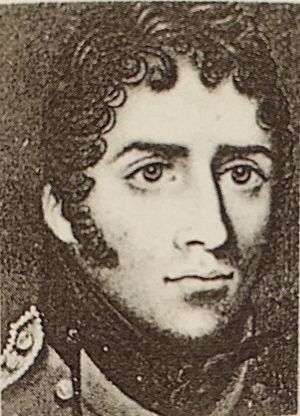Juan Galindo facts for kids
Juan Galindo (born 1802 – died 1840) was an Anglo-Irish adventurer, soldier, and diplomat. He worked for the Liberal government of the Federal Republic of Central America. He is remembered for his diplomatic trips to the United States and England. He also explored parts of Central America and studied ancient Maya ruins. His reports helped him become known as an early expert in Maya archaeology.
Contents
Early Life and Adventures
Juan Galindo was born in Dublin, Ireland, in 1802. His birth name was John Galindo. His father, Philemon Galindo, was English with Spanish roots. His mother, Catherine Gough, was Irish. Both of his parents were actors.
We don't know much about his early life. He left for the New World (the Americas) before he was twenty. Some say he joined Admiral Thomas Cochrane to fight for Chile's freedom. Others say he joined his uncle, who owned a farm in Jamaica.
In 1827, he worked as a secretary and translator for the British consul in Guatemala. By 1828, he was helping improve the port of Iztapa. He was also a major in a Honduras army group.
Working for Central America
In 1829, a group called the Liberals, led by Francisco Morazán, took over Guatemala. Galindo joined them. Morazán's army won quickly. Morazán then created the Federal Republic of Central America. Galindo became a trusted helper for Morazán and Mariano Gálvez, who was the leader of Guatemala. The new government made Galindo a citizen, and he changed his name to Juan.
Galindo took on many military jobs for the new government. He was an officer at a military base in Omoa. He also commanded the port at Trujillo and became the military governor of Petén.
In 1834, he received a huge piece of land in Petén. He was supposed to make peace with the native Lacandon Maya and bring loyal settlers to the area.
Land Disputes and Diplomacy
Galindo soon found out that the border between Guatemala and British Honduras was not clear. The British claimed his new land belonged to them. British mahogany cutters were already cutting down trees there. This meant Galindo was losing the most valuable part of his land.
He tried to solve the problem with Frederick Chatfield in British Honduras, but it didn't work. So, Central America sent Galindo to talk directly with the British government in London.
Galindo left Central America in January 1835. He first stopped in Washington, D.C., hoping the United States would support him against Britain. He even offered information about possible canal routes through Nicaragua. He met with Secretary of State John Forsyth and President Andrew Jackson in May 1835. But he could not get their help.
Galindo then went to London, arriving in August. He met with Foreign Secretary Lord Palmerston. But the talks did not go well. By April 1836, Palmerston decided not to work with Galindo. He said that because Galindo was born a British subject, he could not represent another government.
Without a clear claim to his land in Petén, Galindo could not attract settlers. He asked Central America for another chance and received land on the Mosquito Coast. While still in London, Galindo convinced his father and other family members to lead settlers to this remote coast. This plan failed. The settlers were not prepared, lacked supplies, and could not make a living. By the time Galindo returned to Central America in 1836, the settlement had collapsed, and his father had gone back to England. Galindo also found that he had less influence with the Central American government.
Final Years
The Liberal government in Central America faced many challenges. Galindo tried to gather support against what he saw as British actions, but people were not interested. When a civil war started, he rejoined the army under Liberal general Trinidad Cabañas.
Cabañas's forces were defeated by armies from Honduras and Nicaragua near Tegucigalpa. Juan Galindo was killed on January 30, 1840, after this battle.
Discovering Ancient Maya
Even though it was a small part of his career, Galindo made important discoveries in Maya archaeology.
Exploring Palenque
As military governor of Petén, Galindo went on an exploration trip. He traveled down the Usumacinta River and then overland to reach the ancient Maya ruins at Palenque in April 1831. He spent a month exploring the site. He wrote about the different buildings, drew maps, and sketched many of the decorations he saw. Later that year, his report was published in London and Paris. He also sent a small collection of Maya objects to the Royal Society in London.
Studying Copán
In 1834, the Central American government sent Galindo to study the ruins at Copán. He spent about ten weeks there, writing reports and sketching his findings. He wrote two short reports for publications in London and the American Antiquarian Society. He sent a more detailed report with twenty-six drawings to a society in Paris. The original report was sent to his government, but it was put away and "lost" for over a hundred years. It was finally found and published in 1945.
Galindo was a careful observer and a good writer. He became known as an early expert in Maya archaeology. He wrote many letters sharing his ideas. He was one of the first to notice how similar the modern Maya peoples looked to the carved images of the ancient Maya. He correctly suggested that the ancient Maya civilization was built by the ancestors of the Maya people living today. He was also the first researcher to carefully copy the Maya hieroglyphics and realize they were a unique form of writing.
See also
 In Spanish: Juan Galindo para niños
In Spanish: Juan Galindo para niños


